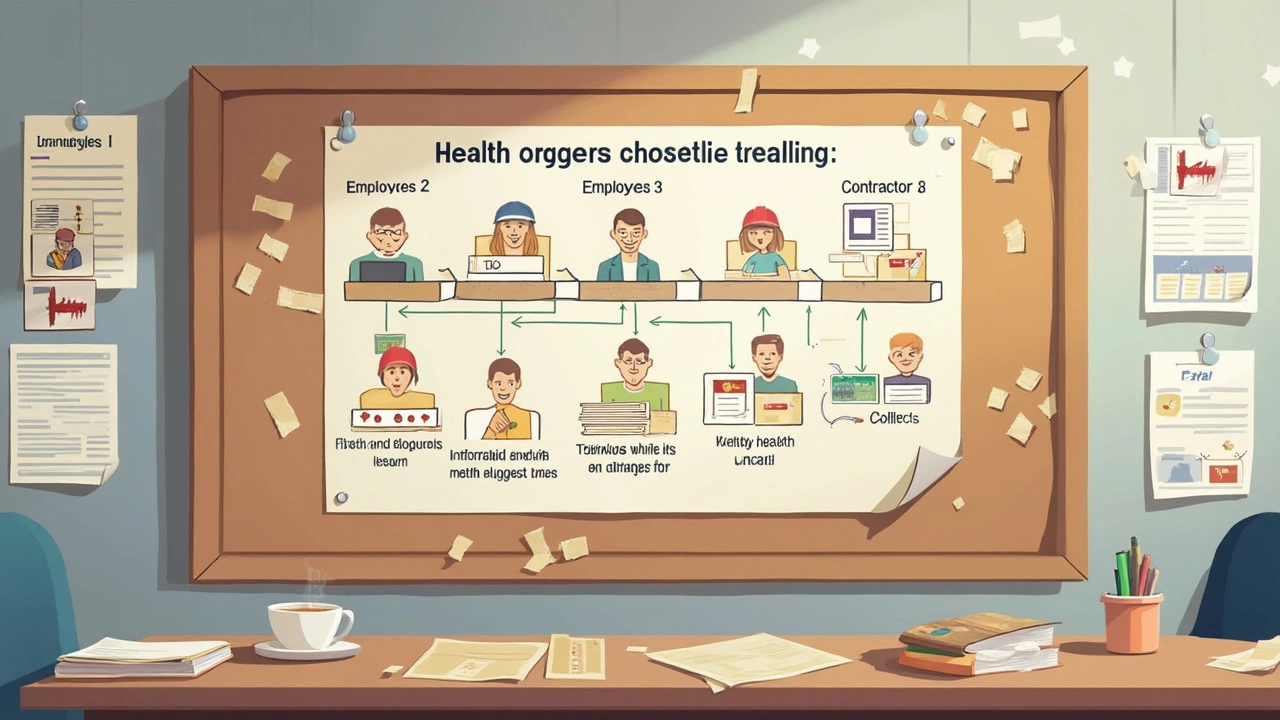Picture this: you show up at a new job and nobody explains how to lift heavy stuff, use equipment, or what the alarm sounds like. Sounds risky, right? That’s exactly what can happen when safety training falls through the cracks. Still, it’s not always obvious who has to make sure everyone’s clued in.
The “whose job is it” question trips up even smart managers and HR folks. Too many think it’s all on the health and safety officer, but legally, the boss (the actual employer) carries the weight. And it isn’t just a suggestion—skip proper training, and you’re flirting with real fines and lawsuits.
But here’s the twist: employees have a piece of the puzzle too. You’re expected to take part in safety training and actually use what you learn. So if you ignore updates or use shortcuts, that’s on you. Want a simple tip? Ask questions and speak up if something doesn’t make sense. It only takes a second to stop an accident before it happens.
- Why Safety Training Even Exists
- Who Actually Sets the Rules?
- The Employer’s Main Role
- Employee Responsibilities You Can’t Ignore
- What Makes Safety Training Effective
- Common Mistakes and How to Dodge Them
Why Safety Training Even Exists
Think about all the ways a regular day at work could go sideways—spills, falls, cuts, burns, chemical leaks, or just plain confusion using gear. Safety training is there to stop these problems before they ever start. The numbers don’t lie: according to OSHA, roughly 2.8 million people in the US get hurt or sick on the job every year. With solid training, that risk drops fast.
It’s not just about rules on paper or ticking a box for HR. Real lives change because someone knows how to handle a fire, spot a trip hazard, or use a machine the right way. Training also spells out what’s allowed and what’s not, so everyone’s on the same page and no one’s left guessing.
Here’s the bottom line: most countries make safety training a legal must. Skip it, and companies face big fines, insurance hikes, or even shut-downs. That’s why it’s more than just a meeting or slide deck—it’s a foundation for every job site, office, or shop.
- It keeps workers out of the hospital (and out of court).
- It protects businesses from lawsuits and lost money.
- It keeps everyone focused, confident, and productive because they aren’t worried about getting hurt.
Even if nothing dramatic has ever happened at your work, things can go wrong fast. Safety training exists to keep those accidents from becoming headlines—and to make sure everyone gets home in one piece.
Who Actually Sets the Rules?
If you think the company just makes up the rules for safety training on the fly, think again. These standards come straight from national and sometimes international laws. In the U.S., for example, OSHA (Occupational Safety and Health Administration) calls the shots. They lay out clear rules for what needs to be taught, how often, and even keep a list of what industries have extra requirements. Over in the EU, it’s the European Agency for Safety and Health at Work setting the pace, and every country has its own spin on these basics.
States or provinces can get even more specific. California, for instance, adds stricter rules (Cal/OSHA), so what flies in Texas might get you fined there. It all comes down to one big thing: ignoring legal rules around training leads to real consequences.
Here’s a quick look at who’s making the big calls on safety standards most often:
- Federal agencies like OSHA or HSE (UK)
- State or provincial labor departments
- Industry groups (like construction or healthcare boards)
- Company policies and in-house safety committees
To give you an idea of how much these rules matter, check out this table of what happens when companies drop the ball on safety training:
| Agency | Year | Fines Issued for Poor Training |
|---|---|---|
| OSHA (USA) | 2024 | $85 million |
| HSE (UK) | 2024 | £11.7 million |
| Safe Work Australia | 2023 | AUD 9.2 million |
The key thing? These rules are set outside your company, but it’s up to every boss and manager to make sure their team follows them. Don’t wait to get this right until you’ve been slapped with a fine.
The Employer’s Main Role
When it comes to safety training, employers can’t just wing it or pass the responsibility elsewhere. Workplace laws are pretty clear: bosses have to make sure everyone gets the proper training before starting risky tasks. The big deal here is “duty of care,” which means it’s not enough to hand someone a manual or toss them a five-minute video. Real, hands-on safety training is the employer’s job, no excuses.
Here’s where it gets serious. The U.S. Occupational Safety and Health Administration (OSHA) can fine your company over $16,000 per violated standard if training isn’t up to par. In the UK, breaches have led to companies paying out millions in compensation after accidents. Cutting corners with safety training just isn’t worth the risk.
So what exactly should employers do? Here’s a quick checklist:
- Identify all potential hazards in the workplace (think: chemicals, machinery, slippery floors).
- Set up clear, written training programs for both new hires and longtime staff.
- Make sure each employee understands job-specific risks and the correct way to handle them.
- Keep training records—yes, real records, not just a ticked box in someone’s memory.
- Update training when something changes: new laws, equipment, or after a close call.
- Give safety info in a language and style your crew gets—graphics, demos, not just words.
Here’s some eye-opening data to back this up:
| Country | Yearly Workplace Deaths Linked to Poor Training | Average Fine (USD) |
|---|---|---|
| USA | Over 800 | $16,131 per violation (OSHA 2024) |
| UK | ~140 | $22,000 per case (HSE 2024) |
| Australia | ~150 | $12,000 (Safe Work Australia 2024) |
It doesn’t matter if you’re running a construction site or an office—if your team isn’t trained and something goes wrong, the blame almost always lands at the employer’s feet. Don’t wait for an accident to check if you’ve done enough. Regularly review and upgrade your approach, and make safety training a real priority.

Employee Responsibilities You Can’t Ignore
Here’s the deal: once you’ve been trained, the responsibility isn’t just on your boss. You, as an employee, have a legal and practical duty to follow safety protocols at work. The Health and Safety at Work Act sets this straight—if you ignore what you’ve learned, you could face serious trouble, not just a slap on the wrist.
For example, in the UK’s 2023 business safety report, over 8,000 workplace injuries came from workers skipping training procedures or failing to use protective equipment. That’s not just an employer’s problem. Most safety rules are written with personal action steps in mind—meaning every worker has to pull their weight.
Here’s what you’re directly on the hook for:
- Take all safety training sessions seriously. Show up, pay attention, and participate. No skipping out.
- Ask questions if you’re confused, especially about new machinery or chemicals. Nobody expects you to guess.
- Use protective gear every time, not just when a supervisor is watching. Hard hats, goggles, gloves—they really do prevent injuries.
- Immediately report broken equipment, unsafe conditions, or any awkward situations you spot—don’t just hope someone else will do it.
- Follow safe lifting techniques, lockout/tagout processes, and fire exit routes as covered in training. Shortcuts here can cost lives.
Want some hard numbers? Here’s what slacking off looks like in cold stats:
| Cause of Incident | Percentage of Preventable Accidents (2023) |
|---|---|
| Not Following Training Procedures | 36% |
| No Use of Provided PPE | 29% |
| Failure to Report Hazards | 18% |
There’s a reason some companies hand out awards for zero incidents. When every employee takes training seriously, the whole workplace gets safer, productivity goes up, and insurance headaches go down. Skip a step or ignore a rule and you’re putting more than yourself at risk—you’re risking everyone’s well-being and sometimes your job, too.
What Makes Safety Training Effective
If you want safety training to actually work, it can’t just be a PowerPoint everyone zones out during. Training that sticks is hands-on, clear, and matches the real work people do every day. The most effective programs are tailored to the actual risks on the job—not just the legal minimums someone found online.
There’s real proof behind this. According to data from the National Safety Council, workplaces with practical, job-specific training see up to 60% fewer accidents compared to those that use boring, generic lessons. That’s a massive difference just for taking the training seriously and making it practical.
- Get interactive: Let people ask questions, use the equipment, and practice emergency steps. Sitting through slides alone isn’t enough.
- Keep it short and focused: Bite-sized info sessions over time beat one giant info dump. People remember what matters the most to them right now.
- Update often: Tech, procedures, and rules change. Training should too, at least once a year or when something new is in the mix.
- Use stories: Real-world examples and stories from coworkers help everyone connect and remember.
- Test and review: Quizzes, drills, and open conversation help make sure the lessons actually stick, not just get checked off a list.
Check out this quick breakdown showing what works best, based on recent workplace surveys:
| Training Method | Reduction in Incidents (%) |
|---|---|
| Hands-on practice | 55% |
| Short, recurring sessions | 48% |
| Story-based lessons | 39% |
| Annual policy review only | 18% |
Makes you think—maybe it’s time to toss that rusty old safety video and get people involved for real.
Common Mistakes and How to Dodge Them
It’s wild how often even big companies trip up on the basics of safety training. And when corners get cut, people get hurt or companies end up paying for it—sometimes big time.
One of the top mess-ups? Treating safety like a one-off event. You’ve probably seen the “annual training day,” where everyone zones out for a couple hours and forgets it by lunch. Real talk: regular and short refresher updates work a lot better. If you’re the boss, set reminders and keep it practical, not just paperwork.
Here’s a quick look at common mistakes and what you can do instead:
- Outdated Info: Too many workplaces use old videos or written materials. Safety rules change fast—update training content at least once a year, or when something big changes.
- Playing the Blame Game: Some managers expect safety officers to handle everything. In reality, leadership, HR, and workers all share the load. Make sure roles are super clear.
- No Hands-On Practice: People remember way more when they actually do stuff, not just watch. Always add demos or hands-on sessions.
- Skipping Proof: If you don’t track who’s been trained and when, you’re asking for trouble. Use digital records or at least a sign-in sheet every session.
Let’s look at what this means for real workplaces. Back in 2023, the National Safety Council shared some eye-opening stats on incidents linked to poor or missing training:
| Year | Number of Training-Related Incidents | Reported OSHA Fines (Million USD) |
|---|---|---|
| 2021 | 2,900 | 18.5 |
| 2022 | 3,200 | 21.7 |
| 2023 | 2,780 | 19.2 |
See the pattern? Incidents and fines pile up when training falls flat. So, what can you do to avoid the landmines?
- Talk with your team after every training—did it make sense? What was unclear?
- Keep your content up to date, especially if you get new gear or change how things are done.
- Never treat sign-offs as a formality. Check that people really get it before they go back to work.
Simple fixes, but they save lives and paychecks. Don’t just tick the box—make it real and make it a habit.





Write a comment